The global PMMA/ASA composite material market is valued at USD 506 million in 2025 and is slated to reach USD 941 million by 2035, recording an absolute increase of USD 435 million over the forecast period. A rolling CAGR review shows a stable 6.4% annual expansion for PMMA ASA composite materials between 2025 and 2035, translating into a rise from USD 506 million to USD 941 million.
The increase of USD 435 million occurs through steady yearly additions rather than any sharp acceleration. Annual gains move from about USD 32 million in 2026 to nearly USD 57 million by 2035 as the installed application base widens. The period between 2025 and 2028 contributes roughly USD 104 million to growth, driven by adoption in exterior trims and paneling where surface durability requirements are consistent. The following three-year block from 2028 to 2031 contributes around USD 125 million, supported by higher integration across molded automotive components and outdoor-facing building materials. The final segment from 2031 to 2035 contributes the largest share at about USD 207 million, indicating that the material enters broader specification lists once validation cycles and standardized compounding guidelines become widely established. The progression indicates a measured substitution pattern rather than a displacement surge, with gains anchored in tested weatherability, surface retention stability, and mechanical reliability across construction and vehicle body applications.
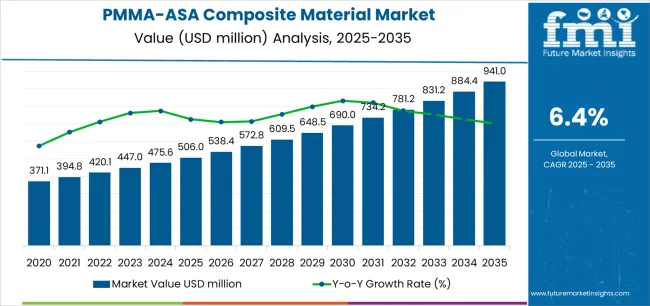
Consumer behavior in the PMMA/ASA composite material market reflects broader manufacturing trends toward high-performance, weather-resistant systems that provide both mechanical strength benefits and extended service-life improvements. The PMMA/ASA composite material market benefits from the growing popularity of injection molding grade applications, which are recognized for their advanced processing integration and user-friendly approach to part fabrication management. Additionally, the versatility of PMMA/ASA composites as both standalone structural materials and integrated component systems supports sustained demand across multiple manufacturing applications and performance segments.
Regional adoption patterns vary significantly, with Asian markets showing strong preference for injection molding implementations, while European markets demonstrate increasing adoption of extrusion-grade solutions alongside conventional automotive manufacturing systems. The manufacturing landscape continues to evolve with sophisticated and feature-rich PMMA/ASA products gaining traction in mainstream automotive brands, reflecting manufacturer willingness to invest in proven polymer technology improvements and performance-oriented features.
The competitive environment features established engineering plastics companies alongside specialized PMMA/ASA providers that focus on unique formulation capabilities and advanced processing methods. Manufacturing efficiency and product development optimization remain critical factors for market participants, particularly as raw material costs and regulatory compliance continue to fluctuate. Distribution strategies increasingly emphasize multi-channel approaches that combine traditional polymer supply chains with direct manufacturer partnerships through technology licensing agreements and system integration contracts.
Market consolidation trends indicate that larger chemical manufacturers are acquiring specialty PMMA/ASA companies to diversify their product portfolios and access specialized polymer processing segments. Original equipment integration has gained momentum as automotive companies seek to differentiate their offerings while maintaining competitive cost structures. The emergence of specialized composite variants, including high-impact and flame-retardant options, reflects changing material priorities and creates new market opportunities for innovative polymer system developers. Manufacturing automation and quality control improvements enable consistent product scaling while maintaining traditional mechanical characteristics that part manufacturers expect from established engineering materials.
Between 2025 and 2030, the PMMA/ASA composite material market is projected to expand from USD 506 million to USD 690.1 million, resulting in a value increase of USD 184.1 million, which represents 42.3% of the total forecast growth for the decade. This phase of development will be shaped by increasing adoption of injection molding grade systems, rising demand for automotive applications, and growing emphasis on weather resistance features with enhanced UV-stability characteristics. Polymer manufacturers are expanding their processing capabilities to address the growing demand for specialized PMMA/ASA implementations, advanced mechanical options, and brand-specific offerings across application segments.
| Metric | Value |
|---|---|
| Estimated Value (2025E) | USD 506 million |
| Forecast Value (2035F) | USD 941 million |
| Forecast CAGR (2025-2035) | 6.40% |
From 2030 to 2035, the PMMA/ASA composite material market is forecast to grow from USD 690.1 million to USD 941 million, adding another USD 250.9 million, which constitutes 57.7% of the overall ten-year expansion. This period is expected to be characterized by the expansion of automotive manufacturing systems, the integration of innovative composite solutions, and the development of specialized material implementations with enhanced mechanical profiles and extended performance capabilities. The growing adoption of advanced formulations will drive demand for PMMA/ASA composites with superior impact resistance characteristics and compatibility with modern processing technologies across automotive manufacturing operations.
Between 2020 and 2025, the PMMA/ASA composite material market experienced steady growth, driven by increasing demand for injection molding grade systems and growing recognition of composite materials as essential components for modern automotive manufacturing programs across transportation and construction applications. The PMMA/ASA composite material market developed as material manufacturers recognized the potential for PMMA/ASA solutions to provide both mechanical strength benefits and operational advantages while enabling streamlined processing protocols. Technological advancement in polymer chemistry and application-based development began emphasizing the critical importance of maintaining material performance and manufacturer acceptance in diverse processing environments.
Market expansion is being supported by the increasing global demand for advanced engineering plastic systems and the corresponding need for PMMA/ASA composite technologies that can provide superior weather resistance benefits and mechanical strength advantages while enabling enhanced part performance and extended compatibility across various automotive manufacturing and construction applications. Modern processors and manufacturing industry specialists are increasingly focused on implementing proven composite technologies that can deliver effective UV protection, minimize traditional weathering dependency, and provide consistent performance throughout complex processing configurations and diverse environmental conditions. PMMA/ASA composites proven ability to deliver exceptional mechanical efficacy against traditional alternatives, enable advanced processing integration, and support modern part fabrication protocols makes it an essential component for contemporary manufacturing and automotive production operations.
The growing emphasis on lightweight materials and manufacturing efficiency optimization is driving demand for PMMA/ASA composites that can support large-scale processing requirements, improve strength outcomes, and enable advanced manufacturing systems. Consumer preference for products that combine effective weather resistance with proven mechanical strength and performance benefits is creating opportunities for innovative PMMA/ASA implementations. The rising influence of automotive design trends and material performance awareness is also contributing to increased demand for PMMA/ASA composites that can provide advanced features, seamless part integration, and reliable performance across extended service periods.
The PMMA/ASA composite material market is poised for steady growth and technological advancement. As manufacturers across North America, Europe, Asia-Pacific, and emerging markets seek systems that deliver exceptional mechanical quality, advanced weather resistance capabilities, and reliable performance options, PMMA/ASA composite solutions are gaining prominence not just as engineering materials but as strategic enablers of part technologies and advanced manufacturing functionality.
Rising injection molding adoption in Asia-Pacific and expanding automotive manufacturing initiatives globally amplify demand, while manufacturers are leveraging innovations in polymer engineering, advanced formulation integration, and processing management technologies.
Pathways like automotive manufacturing implementations, construction-grade platforms, and specialized industrial solutions promise strong margin uplift, especially in premium application segments. Geographic expansion and product diversification will capture volume, particularly where local manufacturing preferences and advanced technology adoption are critical. Regulatory support around material performance standards, UV resistance protocols, and automotive safety requirements give structural support.
The PMMA/ASA composite material market is segmented by grade, application, end user, processing method, impact strength, distribution channel, price range, and region. By grade, the PMMA/ASA composite material market is divided into injection molding grade, extrusion grade, and specialty grade categories. By application, it covers automotive, home appliances, construction, electronics, and other segments. By end user, it encompasses automotive manufacturers, appliance producers, construction companies, and industrial processors. By processing method, the market includes injection molding, extrusion, thermoforming, and blow molding. By impact strength, the PMMA/ASA composite material market is categorized into standard impact, medium impact, and high impact categories. By distribution channel, the market is divided into direct sales, distributors, and online channels. By price range, the PMMA/ASA composite material market includes premium, mid-range, and economy. Regionally, the PMMA/ASA composite material market is divided into North America, Europe, East Asia, South Asia & Pacific, Latin America, and the Middle East & Africa.
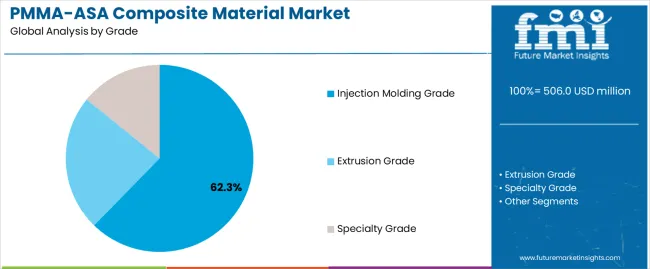
The injection molding grade segment is projected to account for 62.3% of the PMMA/ASA composite material market in 2025, reaffirming its position as the leading grade category. Material manufacturers and system integrators increasingly utilize injection molding grade implementations for their superior processing properties when operating across diverse component platforms, excellent moldability characteristics, and widespread acceptance in applications ranging from basic automotive parts to premium appliance operations. Injection molding grade technology's established processing methods and proven mechanical capabilities directly address the manufacturer requirements for dependable material solutions in complex processing environments.
This grade segment forms the foundation of modern manufacturing adoption patterns, as it represents the implementation with the greatest market penetration and established processor acceptance across multiple application categories and performance segments. Manufacturer investments in grade standardization and system consistency continue to strengthen adoption among component producers and processing companies. With brands prioritizing mechanical performance and processing efficiency, injection molding grade implementations align with both functionality preferences and cost expectations, making them the central component of comprehensive part manufacturing strategies.
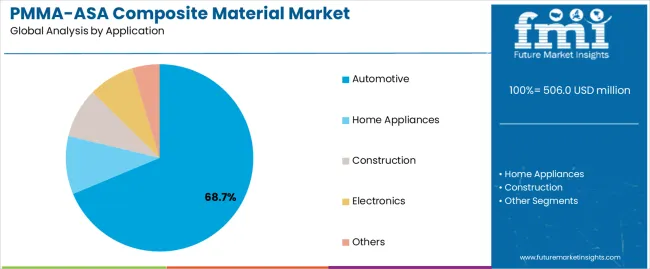
Automotive applications are projected to represent 68.7% of PMMA/ASA composite demand in 2025, underscoring their critical role as the primary application channel for mechanical performance across automotive manufacturing, component production operations, and transportation product applications. Automotive manufacturers prefer PMMA/ASA composites for automotive use for their exceptional weather resistance characteristics, scalable processing options, and ability to enhance part durability while ensuring consistent material quality throughout diverse automotive platforms and manufacturing operations. Positioned as essential structural components for modern automotive production, PMMA/ASA composite solutions offer both technological advantages and processing efficiency benefits.
The segment is supported by continuous innovation in automotive material technologies and the growing availability of specialized implementations that enable diverse automotive requirements with enhanced mechanical uniformity and extended service-life capabilities. Additionally, automotive manufacturers are investing in advanced technologies to support large-scale processing integration and component development. As lightweight material trends become more prevalent and automotive performance awareness increases, automotive applications will continue to represent a major implementation market while supporting advanced automotive utilization and technology integration strategies.
The PMMA/ASA composite material market is advancing steadily due to increasing demand for advanced engineering plastic systems and growing adoption of composite technologies that provide superior weather resistance characteristics and mechanical strength benefits while enabling enhanced part performance across diverse automotive manufacturing and construction applications. The PMMA/ASA composite material market faces challenges, including complex polymer formulation requirements, evolving material regulations, and the need for specialized processing expertise and performance programs. Innovation in composite chemistry and advanced processing systems continues to influence product development and market expansion patterns.
The growing adoption of advanced lightweight materials, sophisticated weight reduction capabilities, and manufacturing performance awareness is enabling system developers to produce advanced PMMA/ASA composite solutions with superior mechanical positioning, enhanced strength profiles, and seamless integration functionalities. Advanced lightweight material systems provide improved performance outcomes while allowing more efficient manufacturing workflows and reliable performance across various component applications and environmental conditions. Developers are increasingly recognizing the competitive advantages of manufacturing integration capabilities for market differentiation and performance positioning.
Modern PMMA/ASA composite providers are incorporating advanced polymer technology, mechanical protocol integration, and sophisticated processing solutions to enhance material appeal, enable intelligent performance features, and deliver value-added solutions to manufacturing customers. These technologies improve composite performance while enabling new market opportunities, including multi-layer systems, optimized surface treatments, and enhanced impact resistance characteristics. Advanced mechanical integration also allows developers to support comprehensive engineering material technologies and market expansion beyond traditional material approaches.
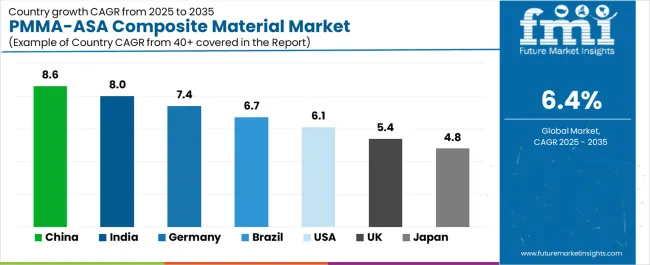
| Country | CAGR (2025-2035) |
|---|---|
| China | 8.6% |
| India | 8% |
| Germany | 7.4% |
| Brazil | 6.7% |
| United States (USA) | 6.1% |
| United Kingdom (UK) | 5.4% |
| Japan | 4.8% |
The PMMA/ASA composite material market is experiencing steady growth globally, with China leading at an 8.6% CAGR through 2035, driven by expanding automotive manufacturing capacity, growing material modernization programs, and significant investment in polymer composite development. India follows at 8%, supported by increasing automotive production expansion, growing manufacturing technology integration patterns, and expanding industrial infrastructure. Germany shows growth at 7.4%, emphasizing automotive technology leadership and material development. Brazil records 6.7%, focusing on expanding manufacturing capabilities and automotive technology modernization. The USA exhibits 6.1% growth, emphasizing automotive innovation excellence and premium material development. The UK demonstrates 5.4% growth, prioritizing advanced manufacturing technology development and material performance trends. Japan shows 4.8% growth, supported by automotive technology initiatives and quality-focused production patterns.
The report covers an in-depth analysis of 40+ countries, the top-performing countries are highlighted below.
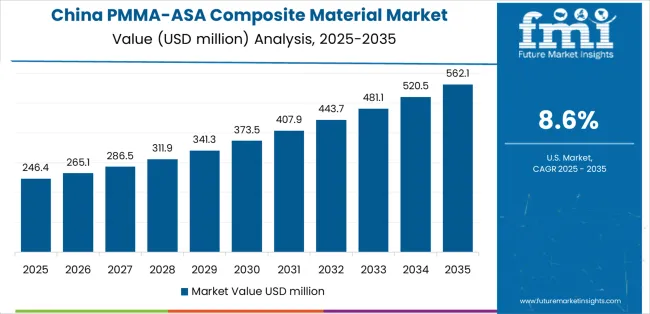
Revenue from PMMA/ASA composite material in China is projected to exhibit robust growth with a CAGR of 8.6% through 2035, driven by expanding automotive manufacturing capacity and rapidly growing material integration supported by government initiatives promoting automotive technology development. The country's strong position in automotive production and increasing investment in manufacturing infrastructure are creating substantial demand for advanced PMMA/ASA implementations. Major automotive manufacturers and technology companies are establishing comprehensive integration capabilities to serve both domestic material demand and expanding export markets.
Revenue from PMMA/ASA composite material in India is expanding at a CAGR of 8%, supported by the country's growing automotive manufacturing sector, expanding material technology capacity, and increasing adoption of lightweight material technologies. The country's initiatives promoting automotive modernization and growing industrial development awareness are driving requirements for technology-integrated material systems. International material providers and domestic automotive manufacturing companies are establishing extensive manufacturing and integration capabilities to address the growing demand for advanced composite solutions.
Revenue from PMMA/ASA composite material in Germany is expanding at a CAGR of 7.4%, supported by the country's automotive technology heritage, strong emphasis on material performance technology, and robust demand for advanced composite systems in automotive and industrial applications. The nation's mature automotive sector and technology-focused operations are driving sophisticated PMMA/ASA implementations throughout the manufacturing industry. Leading manufacturers and automotive specialists are investing extensively in material development and advanced integration technologies to serve both domestic and international markets.
Revenue from PMMA/ASA composite material in Brazil is growing at a CAGR of 6.7%, driven by the country's expanding automotive manufacturing sector, growing industrial material programs, and increasing investment in manufacturing technology development. Brazil's large automotive market and commitment to manufacturing advancement are supporting demand for diverse PMMA/ASA solutions across multiple application segments. Manufacturers are establishing comprehensive integration capabilities to serve the growing domestic market and expanding manufacturing opportunities.
Revenue from PMMA/ASA composite material in the USA is expanding at a CAGR of 6.1%, supported by the country's advanced automotive technology sector, strategic focus on material performance solutions, and established manufacturing capabilities. The USA's automotive innovation leadership and technology integration are driving demand for specialized PMMA/ASA implementations in premium products, automotive applications, and advanced manufacturing systems. Manufacturers are investing in comprehensive technology development to serve both domestic specialty markets and international quality applications.
Revenue from PMMA/ASA composite material in the UK is growing at a CAGR of 5.4%, driven by the country's focus on material technology advancement, emphasis on premium product innovation, and strong position in manufacturing development. The UK's established material innovation capabilities and commitment to technology diversification are supporting investment in specialized PMMA/ASA technologies throughout major manufacturing regions. Industry leaders are establishing comprehensive technology integration systems to serve domestic premium product production and material applications.
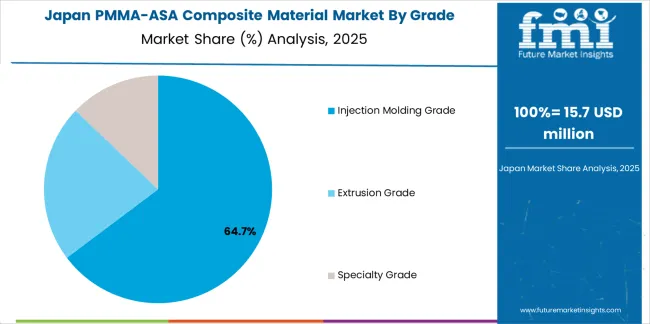
Revenue from PMMA/ASA composite material in Japan is expanding at a CAGR of 4.8%, supported by the country's material excellence initiatives, growing quality technology sector, and strategic emphasis on advanced product development. Japan's advanced quality control capabilities and integrated manufacturing systems are driving demand for high-quality PMMA/ASA platforms in premium products, automotive technology, and advanced manufacturing applications. Leading manufacturers are investing in specialized capabilities to serve the stringent requirements of technology-focused manufacturing and premium product industries.
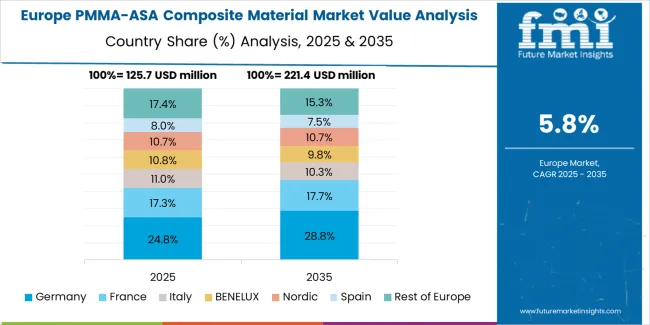
The PMMA/ASA composite material market in Europe is projected to grow from USD 142.7 million in 2025 to USD 265.8 million by 2035, registering a CAGR of 6.4% over the forecast period. Germany is expected to maintain its leadership position with a 41.8% market share in 2025, growing to 43.2% by 2035, supported by its strong automotive engineering culture, sophisticated manufacturing capabilities, and comprehensive automotive industry serving diverse PMMA/ASA composite applications across Europe.
France follows with an 17.9% share in 2025, projected to reach 17.4% by 2035, driven by robust demand for automotive material technologies in manufacturing applications, advanced industrial programs, and automotive markets, combined with established manufacturing infrastructure and technology integration expertise. The United Kingdom holds a 15.1% share in 2025, expected to reach 14.6% by 2035, supported by strong material technology sector and growing premium product activities. Italy commands an 11.4% share in 2025, projected to reach 10.9% by 2035, while Netherlands accounts for 7.2% in 2025, expected to reach 7.5% by 2035. Spain maintains a 4.8% share in 2025, growing to 5% by 2035. The Rest of Europe region, including Nordic countries, Eastern Europe, Belgium, Poland, and other nations, is anticipated to maintain momentum, with its collective share moving from 1.8% to 1.4% by 2035, attributed to increasing manufacturing modernization in Eastern Europe and growing technology penetration in Nordic countries implementing advanced material performance programs.
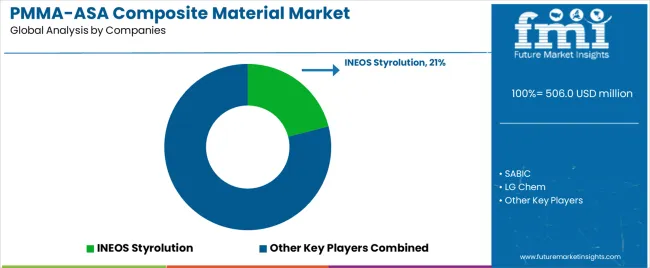
The PMMA/ASA composite material market is characterized by competition among established engineering plastics companies, specialized composite technology developers, and integrated material solution providers. Companies are investing in polymer chemistry research, processing optimization, advanced composite system development, and comprehensive material portfolios to deliver consistent, high-quality, and application-specific PMMA/ASA composite solutions. Innovation in advanced mechanical integration, weather resistance enhancement, and processing compatibility improvement is central to strengthening market position and competitive advantage.
INEOS Styrolution leads the PMMA/ASA composite material market with a 21% market share, offering comprehensive material technology solutions, including quality composite platforms and advanced integration systems, with a focus on premium and automotive manufacturing applications. SABIC provides specialized polymer capabilities with an emphasis on advanced PMMA/ASA implementations and innovative material solutions. LG Chem delivers comprehensive material services with a focus on integrated platforms and large-scale processing applications. LOTTE Chemical specializes in advanced composite technologies and specialized PMMA/ASA implementations for premium applications. Wanhua focuses on consumer-oriented material integration and innovative technology solutions.
INEOS Styrolution
SABIC
LG Chem
LOTTE Chemical
Wanhua Chemical
Bhansali Engineering Polymers
| Item | Value |
|---|---|
| Quantitative Units | USD 506 million |
| Grade | Injection Molding Grade; Extrusion Grade; Specialty Grade |
| Application | Automotive; Home Appliances; Construction; Electronics; Others |
| End User | Automotive Manufacturers; Appliance Producers; Construction Companies; Industrial Processors |
| Processing Method | Injection Molding; Extrusion; Thermoforming; Blow Molding |
| Impact Strength | Standard Impact; Medium Impact; High Impact |
| Distribution Channel | Direct Sales; Distributors; Online Channels |
| Price Segment | Premium; Mid-range; Economy |
| Regions Covered | North America; Europe; East Asia; South Asia & Pacific; Latin America; Middle East & Africa |
| Countries Covered | China; India; Germany; Brazil; United States; United Kingdom; Japan; France; and 40+ additional countries |
| Key Companies Profiled |
INEOS Styrolution, SABIC, LG Chem, LOTTE Chemical, Wanhua Chemical, Bhansali Engineering Polymers |
| Additional Attributes | Dollar sales by grade and application category; regional demand trends; competitive landscape; technological advancements in polymer engineering; advanced formulation development; mechanical innovation; processing integration protocols |
The global PMMA-ASA composite material market is estimated to be valued at USD 506.0 million in 2025.
The market size for the PMMA-ASA composite material market is projected to reach USD 941.0 million by 2035.
The PMMA-ASA composite material market is expected to grow at a 6.4% CAGR between 2025 and 2035.
The key product types in PMMA-ASA composite material market are injection molding grade, extrusion grade and specialty grade.
In terms of application, automotive segment to command 68.7% share in the PMMA-ASA composite material market in 2025.






Full Research Suite comprises of:
Market outlook & trends analysis
Interviews & case studies
Strategic recommendations
Vendor profiles & capabilities analysis
5-year forecasts
8 regions and 60+ country-level data splits
Market segment data splits
12 months of continuous data updates
DELIVERED AS:
PDF EXCEL ONLINE
Composite Resin Market Size and Share Forecast Outlook 2025 to 2035
Composite Pin Insulator Market Size and Share Forecast Outlook 2025 to 2035
Composite Roller Market Size and Share Forecast Outlook 2025 to 2035
Composite Insulator Market Size and Share Forecast Outlook 2025 to 2035
Composite Paper Cans Market Size and Share Forecast Outlook 2025 to 2035
Composite Drums Market Size and Share Forecast Outlook 2025 to 2035
Composite Textile Production Equipment Market Size and Share Forecast Outlook 2025 to 2035
Composite Cans Market Size and Share Forecast Outlook 2025 to 2035
Composite Film Market Size and Share Forecast Outlook 2025 to 2035
Composite Cardboard Tube Packaging Market Size and Share Forecast Outlook 2025 to 2035
Composite Cylinder Market Size and Share Forecast Outlook 2025 to 2035
Composite Tooling Market Outlook- Share, Growth and Forecast 2025 to 2035
Composite Cardboard Tubes Market from 2025 to 2035
Composite IBCs System Market from 2025 to 2035
Market Share Breakdown of Composite Paper Cans Manufacturers
Breaking Down Market Share in Composite Cardboard Tube Packaging
Key Players & Market Share in Composite Cylinder Production
Analyzing Composite Insulator Market Share & Industry Trends
Composite Door & Window Market Growth – Trends & Forecast 2024-2034
Composite AI Market Insights – Growth & Forecast 2024-2034

Thank you!
You will receive an email from our Business Development Manager. Please be sure to check your SPAM/JUNK folder too.
Chat With
MaRIA